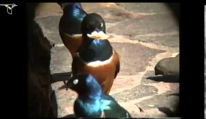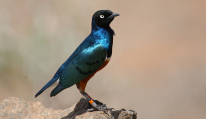Social Structure
As many as six pairs of superb starlings nest near each other. Juveniles help feed the chicks.
Communication
The superb starling’s song is long, rising and falling with skirls and squeals. In flight, its call is skrrrrrri.
Behavior
Superb starlings are gregarious and usually spend the hottest hours of the day in the shade, preening and singing.
Diet
Superb starlings are omnivores that hunt on the ground for seeds and fruit as well as insects and other invertebrates, including crop pests. They sometimes become pests themselves by feeding on farmers’ grains.
Breeding
Pairs begin the breeding season by performing jumping displays, with wings outstretched and heads bowed. They build a nest of grass, leaves, and twigs, usually in a thorn bush, but sometimes in a cliff-side hole. Both parents incubate the two to five eggs for 13 to15 days. Chicks fledge in about three weeks.
Friends & Foes
Superb starlings are often seen with similarly colored Hidebrandt’s starlings.
Population in Kenya
Superb starlings are common throughout Kenya, excerpt for populated areas in western Kenya and along the coast south of Malindi. They favor open woodlands, farms, gardens, and urban areas.
Range & Habitat
The superb starling is found in northeast Africa from southern Sudan through Ethiopia to Somalia and south to Uganda, Kenya, and Tanzania. It lives in woodland and thorn bush, around farms, and in urban parks.


















